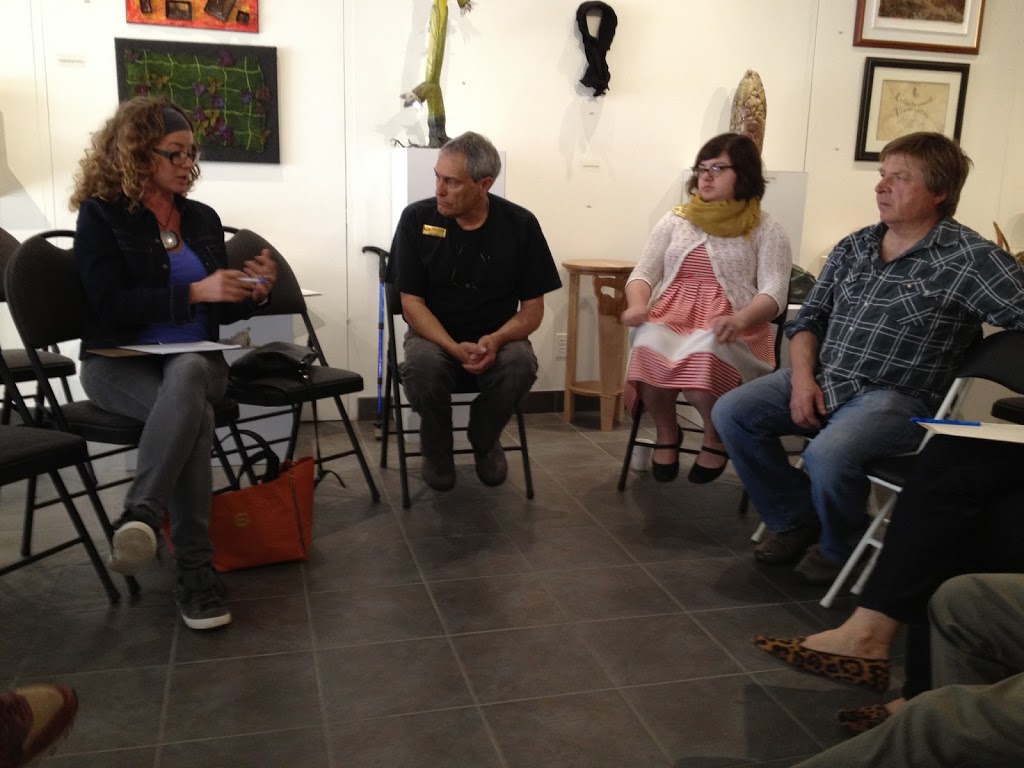Submitted by: Leslie Potter, Exhibitions and Education Coordinator
Meeting in the middle of the many and varied pieces from the exhibition, “The Jury’s Out“, we held our final discussion (round table style) on the jurying process. This was a continuation from the panel discussion held previously and consisted of a small, but vigorous group of makers. Discussion branched out from what was talked about at the previous panel. Questions about the different kinds of jurying were fielded. For example, jurying for Dimensions focuses on putting an exhibition together from all the works submitted, while jurying for markets focuses on a single maker and what they create. Clearly these have different intents. As well, we talked about the differences between curating and jurying. Curating an exhibition for a venue like Affinity Gallery can often be thematic or medium-based and does not consider whether one piece is “better” or “more successful” than another.
 |
| Ceramic artist Bonnie Gilmour poses questions to SCC Exhibition Coordinators Leslie Potter & Stephanie Canning, and one of this years Dimensions jurors, Michael Hosaluk |
One part of the discussion dealt with how we can improve an exhibition such as Dimensions. Questions such as, “how are jurors chosen” and “what constitutes new work” were posed. As well, there was a discussion on why some makers choose not to enter Dimensions.
To answer the first question, the SCC Exhibition Coordinators select the jurors and strive to have a balance in mediums from year to year. One juror is selected from outside the province, also to provide a balance. Secondly, new work is at the discretion of the maker. Obviously if a piece is 10 years old, some eyebrows may be raised. Previously there were tight restraints about “new work”. It had to be made within the year and it could not have been show anywhere previously. These restraints were dropped a few years ago and is reflected in our “Call for Entry”.
 |
| Participants in the round table discussion sat in Affinity Gallery surrounded by “The Jury’s Out” |
The discussion did not answer why some people choose not to enter Dimensions, but obviously some people do not need this venue. Also, some makers who do submit do not necessarily submit their best. So we are indeed missing some makers and some pieces. However, overall, Dimensions continues to be the highest caliber show of its kind in this province. And, if we continue to pursue excellence, Dimensions may hang around a bit longer. Everyone felt that it was a very worthwhile endeavor. Even submitting the actual works as opposed to submitting photographs of the works was, I think, considered an important feature.
Another area of discussion was how to improve the process. When Dimensions first started, there was time for the jurors to talk individually to the entrants. This became problematic when the jurying no longer took place at the Saskatchewan Handcraft Festival in Battleford, where jurors stayed an extra day in order to do this. At this round table discussion several voices recommended that we try to do this again. Another suggestion was that entrants only submit one piece, instead of two. This would mean that entrants would have to “jury” themselves a bit more, but also it would give more time for the jury to meet individual craftspeople for a few minutes. (Remember we had 202 entries this year!!)
Another suggestion was to keep the jurors names a “secret” until all pieces were submitted in order to dissuade makers from catering to a particular juror’s taste.
We will consider these suggestions, and may very well implement some of them in the next run of Dimensions. (In other words, be careful what you wish for!!)
Thanks to everyone who turned out to these discussions, and especially to the former jurors along with Mike Hosaluk who turned out to participate.
